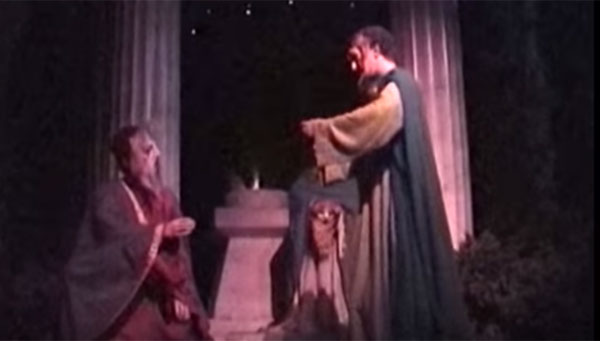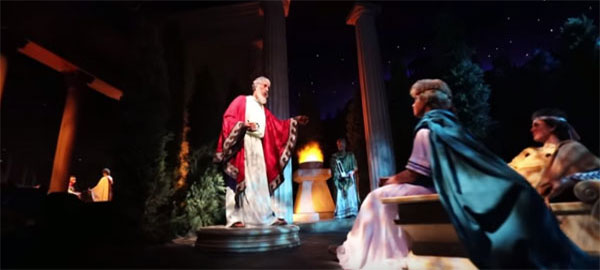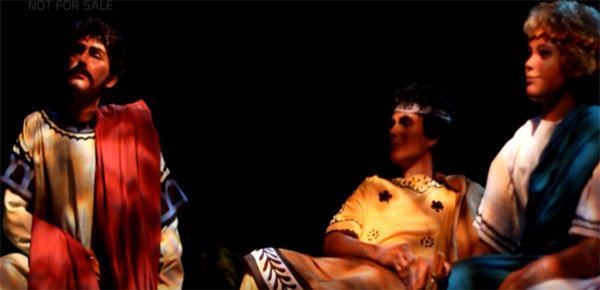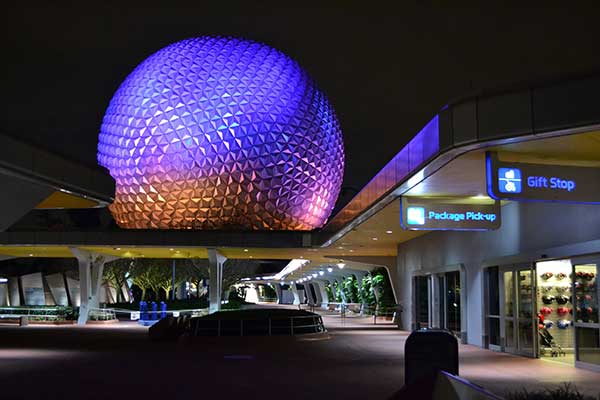
Thus far in this Spaceship Earth, Scene by Scene series, I’ve mostly explored changes that slightly modified the focus of each scene. We have seen considerable script updates with each redo, but the general feeling has been similar. That trend has largely held true with the Greeks scene, at least until the 2007 version. The most recent edits completely shifted the message away from the origins of theater. While past narrators proclaimed, “the theater is born”, Judi Dench now talks about mathematics. This move connects to the overall theme of innovation through technology.
It’s easy for our minds to play tricks on us when looking back at past theme park attractions. I did not remember that the animatronics on this scene wore masks as recently as the Jeremy Irons version. Neil Engel, Art Director of the 2007 update, clarified to me that the teacher needed a new face because there was no face behind the mask. The current ride has been in place for more than 11 years, which helps to explain my lack of clarity about past versions. Thankfully, past editions remain on YouTube so we can remember the differences.
Looking back at the 1982 attraction, Vic Perrin speaks eloquently about this important achievement. He states, “Deep in the shadows of Mount Olympus, our alphabet takes rout…flowering with new expression. Hail the proud Greeks: Aeschylus, Sophocles, Euripides. The theater is born.” This is the only example where specific thinkers are cited, and it matches the more high-minded style at the start. What I like about this approach is how important it feels. We’re witnessing something magical that ultimately leads to entertainment today.

Presenting the Theater
Before we dive further into the 2007 updates, let’s journey back to past theater scenes. In the first three versions, we see two masked actors performing “Oedipus Rex” by Sophocles. As I mentioned earlier, Perrin identifies the author directly. Walter Cronkite gives a more general description of what is happening on stage. Here is the famous news anchor’s narration:
“In classic Greece, the alphabet grows and flowers with new expression and a new stage of
storytelling emerges. A stage on which we examine our world and ourselves. The theater is born.”
Cronkite and Perrin end their comments in the same way, which is actually rare. Both also connect the theater directly back to the alphabet of the Phoenicians. The difference with Cronkite is the way his words relate this scene to how the stage relates to humanity. It’s a place where we “examine our world and ourselves”. Instead of just presenting history, this scene now fits within the framework of our modern lives. Surprisingly, Irons’ narration pulls back from this approach and is closer to Perrin’s words. Here is the description from Irons:
“In ancient Greece, the spoken word was elevated to a fine art. Philosophers debated with
one another in plazas and storytellers found a new forum for personal expression. The theater was born.”
Irons focuses more on artistry and creativity in this communication. He also references philosophers and debates along with storytellers. The theater gives humans a chance to create art and discuss pertinent issues. This change brings a grander scale, which is common for the 1994 Spaceship Earth. Instead of looking inward, this ride expands the story to epic proportions. The elevated music echoes the point that this is a pivotal moment. That trend does not continue with Dench’s revised scene.

A Major Overhaul
The music in the 2007 version lacks the same grandeur and replaces it with a tune that inspires curiosity. This adjustment connects to the focus on learning. Three animatronics are now seated while a single figure teaches them mathematics. Engel also noted that the figure that is furthest from our viewpoint is only 4.5 feet tall due to forced perspective. They also moved two loungers from the right side of the Renaissance scene to the benches here. I love the idea of using these animatronics in a completely different way. Engel added a silhouette perspective of the Grecian skyline to the left side of this scene including Italian cypress trees and a classical building.
The teacher represents the most impressive changes to the animatronics in 2007. His expressive moves make it easy to become immersed. It also connects to modern classrooms and fits the goal of this version to reach out to our daily lives. The teacher stands on a new pedestal in the middle while the less expressive figures watch him passively. Engel also mentioned that the teacher is now holding an astrolabe — a two-dimensional model of a celestial sphere. This astronomical instrument was once commonly used, and the term means “the one who catches heavenly bodies”.
The changes to the animatronics and the background create a more detailed experience in the 2007 version. The lighting and music fit perfectly to deliver a compelling scene. Despite the drastic changes away from theater, this scene still works in the overall presentation. It’s a fairly brief moment, and the Romans are right around the corner. What makes it stick with us are the stunning lead animatronic and the effective staging of each character.

A Memorable Change
It’s telling that I barely remembered this scene from previous versions beyond Irons’ powerful reading of “the theater is born”. That line remains etched in my brain, but the rest is murkier. With the current version, the change to mathematics leads to a stronger scene and a better connection to the new theme. Dench stresses learning and innovation from our past, and math remains a crucial part of education today. This moment does more than look back at a past achievement; it provides the origins of a way of thinking that is still relevant. Spaceship Earth works best when it uses history as a way to connect to today’s journey, and this scene fits that mold.
Next time, we’ll travel a little further up the sphere and experience the grand Roman Empire. I have a feeling all the changes may not resonate so well in that scene.
Sources: INTERCOT, Martin’s Videos

Related Articles: The Theater
Spaceship Earth, Scene by Scene: The Introduction
Spaceship Earth, Scene by Scene: The Cro-Magnon
Five Steps to Enhance Spaceship Earth



A great read as always!
Thanks Melissa! I’m glad you enjoyed it.